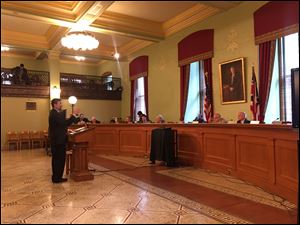
Legislative panel hears from scientists on Lake Erie
8/28/2018
Chris Winslow, director of Ohio Sea Grant and Ohio State’s Stone Lab, testifies before special state legislative committee created to study the health of Lake Erie.
COLUMBUS — An Ohio State University researcher examining the phosphorous runoff that feeds chronic toxic algal blooms in Lake Erie told lawmakers Tuesday that it might be more economically efficient to pay farmers rather than force them to try harder to keep fertilizers on their land.
“The cheapest approach would appear to be to implement a direct payment to farmers who demonstrate phosphorous reduction, a phosphorous tax or market-based trading program,” said Cathann Kress, vice president of agricultural administration and dean of the College of Food, Agricultural, and Environmental Sciences.
She estimated before a special legislative task force that the cost for implementing best-management practices could require payments of $27 per acre for farmers to plant cover crops, $63 an acre to follow nutrient management plans, and $108 an acre to install filter strips.
Algal blooms have recurred again this summer. While the immediate threat to water supplies appears to be fading at least for this season, it’s the seasons ahead that the task force was created to target.
The task force was created in the wake of Gov. John Kasich’s signing last month of an executive order directing his administration to ask the independent Ohio Soil and Water Commission to declare eight full and partial watersheds in the Maumee River Basin as distressed.
That would have triggered tighter regulation of the practices of some 7,000 farmers in the region.
The order was met with strong opposition from many farmers and praise from some environmental groups that called it a good first step.
The commission, by a vote of 4-2, punted the issue to a subcommittee that will meet for the first time Thursday to discuss the request.
“Farmers have long been in a race to increase yield as an indicator to being a successful farmer,” Ms. Kress said. “We are now asking farmers to forgo yield as the measure of record and to focus on maximizing profitability by not focusing on yield but on efficiency.”
The Kasich administration’s request would have redesignated the Platter Creek, Little Flat Rock Creek, Little Auglaize River, Eagle Creek, Auglaize River, Blanchard River, St. Marys River, and Ottawa River watersheds or subwatersheds. Together they represent about 40 percent of Ohio’s share of Lake Erie’s western basin.
Chris Winslow, director of Ohio Sea Grant and Ohio State’s Stone Lab, noted that the Maumee and Sandusky rivers are largely responsible for the phosphorous delivered to Lake Erie. Nearly 80 percent of the land use in these areas is agricultural.
“This is not any finger-pointing or blame game scenario,” he said. “This is just reality.”
He said laws passed in recent years to regulate manure application and require better training for farmers who use fertilizers were good early steps. Studies also show, he said, that injecting fertilizers into the soil rather than broadcasting it on the surface, soil testing, planting of cover crops, and use of phosphorous-free fertilizers are effective.
The question, as Ms. Kress pointed out, is how to sustain the ecosystem, maintain viable farm production, and protect the state’s food and water supply — all at the same time.
“I think everybody in this room wants to clean up the lake, but we want to do it from a science, data-based perspective,” said Sen. Bob Peterson (R., Sabina), a farmer and committee member. “There’s not a lot of things that we can obviously point to say this is the solution, this will work 100 percent of the time, because of the variability across farmland and how we farm across this state.”
Contact Jim Provance at jprovance@theblade.com or 614-221-0496.